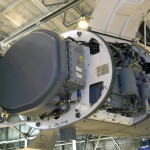
Lockheed Martin unveiled the new version of the F-16 at the Singapore Airshow. The F-16V will feature enhancements including an active electronically scanned array (AESA) radar, an upgraded mission computer, communications capabilities and improved cockpit – all capabilities identified by the U.S. Air Force and several international customers for future improvements. AESA radars offer significant operational capability improvements. Two AESA radar models – Northrop Grumman’s SABR and Raytheon’s RACR are currently available for the F-16V.

According to Lockheed Martin aeronautics VP business development, George Standridge, at present only U.S. made radars are cleared for the package, while insertion of foreign AESA radar is feasible, customers requiring such feature will have to request approval form the Department of Defense.
The F-16V configuration is an option for new production jets and elements of the upgrade are available to most earlier-model F-16s. The “V” designation is derived from Viper, the name fighter pilots have called the F-16 from its beginnings.
“We believe this F-16V will satisfy our customers’ emerging requirements and prepare them to better inter-operate with the fifth generation fighters, the F-35 and F-22,” says Standridge. “Air forces that operate F-16 today will continue to operate the platform for many years to come,” he added “The V upgrade “just means your F-16s can now operate alongside your F-35s”.

With nearly 4,500 F-16s delivered, the F-16V seems a natural step in the evolution of the F-16 ‘Fighting Falcon’. The program has continually evolved as it began with the F-16 A/B as the lightweight fighter then transitioned to F-16 C/D and Block 60 versions as customers’ requirements changed.
In recent years the F-16 has won new orders in Morocco, Egypt, Oman and Iraq carrying the production line through 2015. Lockheed Martin is looking for new opportunities that would carry the line through 2016-17. An upgrading program for 300 aircraft is currently considered by the U.S. Air Force; parallel programs currently underway in several Asian countries, including Singapore, Indonesia, Taiwan and South Korea.




















